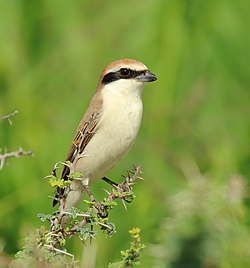| Red-tailed shrike | |
|---|---|
 | |
| Scientific classification | |
| Domain: | Eukaryota |
| Kingdom: | Animalia |
| Phylum: | Chordata |
| Class: | Aves |
| Order: | Passeriformes |
| Family: | Laniidae |
| Genus: | Lanius |
| Species: | L. phoenicuroides |
| Binomial name | |
| Lanius phoenicuroides (Schalow, 1875) | |
 | |
Breeding range of Lanius (isabellinus) phoenicuroides Breeding range of Lanius isabellinus Overwintering range | |
The red-tailed shrike or Turkestan shrike [2] (Lanius phoenicuroides) is a member of the shrike family (Laniidae). It was formerly considered conspecific with the isabelline shrike and the red-backed shrike.



